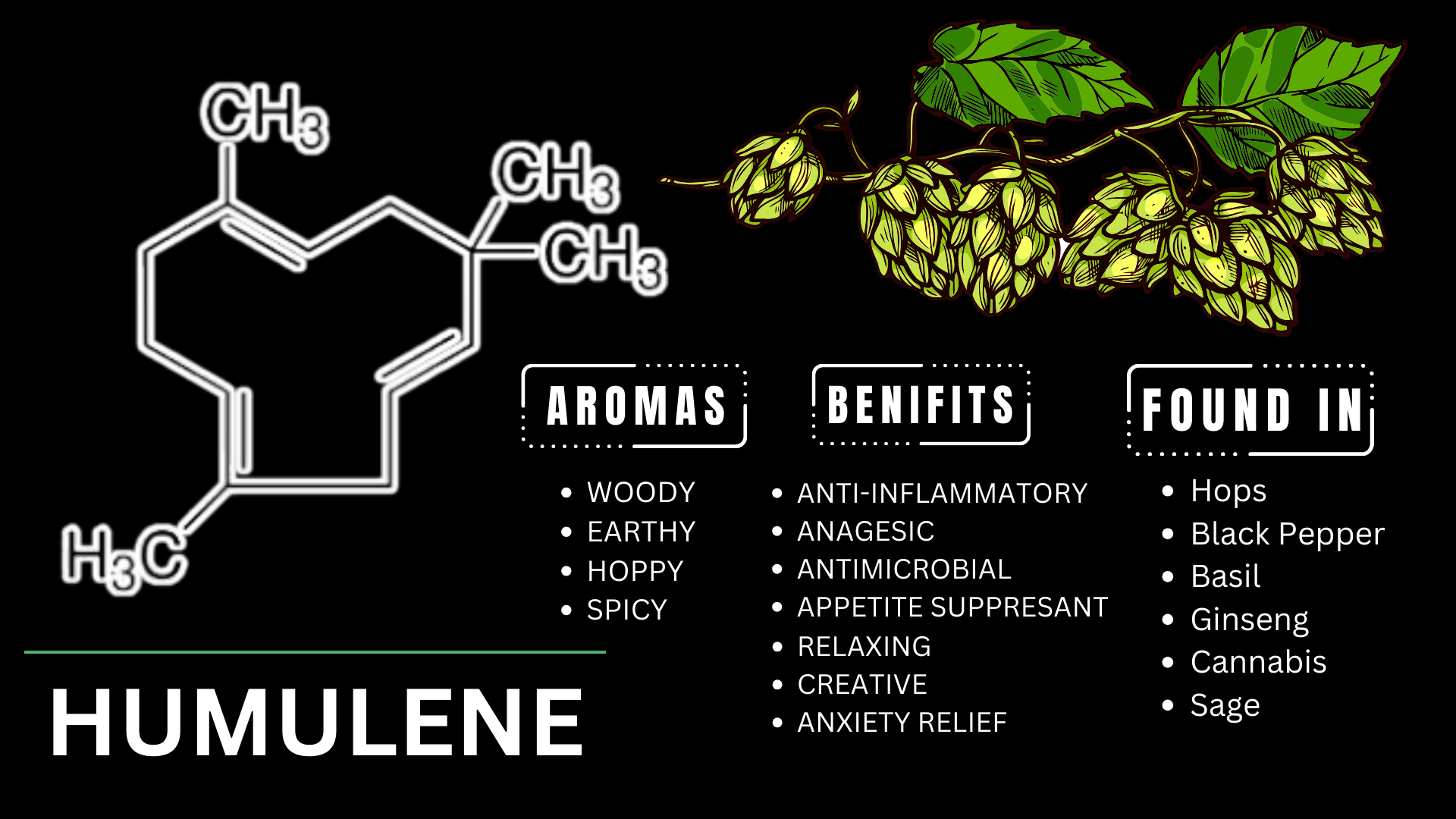Uncategorized
HUMULENE TEREPENE: BENEFITS, EFFECTS, AND STRAINS
Humulene terpene (also known as alpha humulene or alpha caryophyllene), a common terpene found in various plants, including cannabis, has gained attention for its unique aroma and potential therapeutic properties. Belonging to the sesquiterpene family of compounds, it is known for its distinct earthy and woody scent.
Researchers have been studying this for its potential anti-inflammatory and analgesic effects. Preliminary studies suggest that it may have the ability to reduce inflammation and provide pain relief. This makes humulene an intriguing compound that could offer natural alternatives for those seeking relief from inflammatory conditions or chronic pain.
WHAT IS A TERPENE?
Terpenes, organic compounds found in plants and some insects, are known for their strong odors and roles in ecological interactions, such as deterring herbivores and attracting pollinators. They are pivotal in forming essential oils, used in perfumery and aromatherapy, and influence various biological and ecological functions, including cell growth modulation and plant defense mechanisms.
In the realm of cannabis, terpenes like myrcene and limonene contribute to the distinct aromas and flavors of different strains cannabis plants. They are also studied for their potential therapeutic applications and their possible synergistic effects with cannabinoids, known as the “entourage effect,” impacting aspects like pain management and the modulation of THC’s psychoactive effects.
WHAT ARE THE HUMULENE EFFECTS?

This terpene plays a significant role in giving hops their unique aroma. When you crack open a cold craft beer, that distinct smell can be attributed to humulene. It has a woody, earthy, and slightly spicy scent that adds depth and complexity to the overall fragrance.
WOODY, EARTHY, AND SLIGHTLY SPICY AROMA
The alpha humulene aroma profile is often described as woody, earthy, and slightly spicy. Imagine taking a walk through a forest after it has rained – that fresh, natural scent in the air captures the essence. It contributes to the overall sensory experience of various products like beer, essential oils, and even some skincare products. It gives spicy notes and is defientely a earthy terpene with the crisp taste and the similar aromas found in many plants such as sage or balsam fir.
POTENTIAL ANTI-CANCER PROPERTIES
Research suggests that it may possess anti-cancer properties. While further studies are needed alpha humulene to fully understand its potential benefits in treating cancer, initial findings are promising because it exhibits therapeutic anti-inflammatory properties that inhibit certain enzymes responsible for inflammation in the body. This could potentially help reduce the risk of chronic diseases such as cancer by fighting those cancer cells.
ANTIBACTERIAL AND ANTIFUNGAL ACTIVITIES
In addition to its potential anti-cancer properties, it also exhibits the same chemical formula that can be in natural compounds found in properties that have antibacterial properties and anti-fungal activities. These properties make it an intriguing compound for exploring natural alternatives in fighting against harmful microorganisms. By inhibiting bacterial growth and preventing fungal infections, it showcases its versatility beyond just providing aromatic qualities. You can use marijuana plants that are high in humulene as even a topical application to help with this.
ENHANCING DIGESTION
Another interesting effect is its ability to enhance digestion. Some studies suggest that this terpene may aid in improving gut health by stimulating digestive enzymes and promoting healthy bowel movements. By supporting proper digestion, it can contribute to overall well-being and alleviate common digestive issues.
POTENTIAL PAIN-RELIEVING PROPERTIES
Humulene is theorized to interact with the body’s endocannabinoid system, a network of receptors regulating various physiological functions, including pain perception, mood, appetite, and sleep. While further research is essential to fully comprehend its interactions, initial studies suggest that humulene may modulate cannabinoid receptors, and pathways within this system, potentially offering anti-inflammatory properties and aiding in pain management by altering pain signaling.
MANAGING ALLERGIES AND ASTHMA SYMPTOMS
Recent research suggests that it also may be beneficial in managing allergies and asthma symptoms. While more studies are needed to fully understand its potential benefits in this area, early findings show promising results. It is believed that because of its anti-inflammatory properties they can play a role in reducing allergic reactions and improving respiratory function.
POTENTIAL HEALTH BENEFITS
Although much research is still needed to fully explore the health benefits of this unique terpene, preliminary studies indicate its potential advantages beyond just anti-inflammatory effects. It also has been studied for its potential as an appetite suppressant, making it an intriguing compound for those looking to manage their weight, see weight loss or control cravings further adding to its several potential health benefits already.
COMPLEMENTARY EFFECTS WITH OTHER TERPENES
Of course it works synergistically with other terpenes, enhancing their effects and creating unique combinations. For instance, when paired with myrcene, another common terpene found in the cannabis plant and hops, it can enhance sedative properties. This interaction showcases the complexity of terpenes and how they contribute to the overall experience of different plants and products. Check the chart below to learn some of the cannabis terps and their smells, benefits and where else they can be found which is in many other plants and spices/fruits/foods you might already be familiar with.

STRAINS HIGH IN HUMULENE: PSYCHOACTIVE POTENTIAL
Certain cannabis strains are known to contain high levels of humulene. The presence of it in these strains may have potential psychoactive effects, although the overall experience can be influenced by the presence of other cannabinoids. Most strains that humulene plays a big roll in can help produce some of the benefits from it or get different attributes from it like the sedative effects that might come from it.
SOUR DIESEL: A POTENT STRAIN WITH HUMULENE PUNCH
Sour Diesel is one strain that is often associated with high levels of humulene. This sativa-dominant strain not only contains humulene but also boasts a complex aromatic profile that includes notes of diesel fuel, citrus, and earthiness. The combination of humulene and other terpenes gives sativa strains Sour Diesel its distinct aroma and potentially potent psychoactive effects.

GIRL SCOUT COOKIES: SWEETNESS MEETS HUMULENE
Another popular strain known for its humulene content is Girl Scout Cookies. This hybrid strain offers a delightful blend of sweetness and earthiness, making it a favorite among cannabis enthusiasts. Alongside its unique flavor profile, GSC also provides a potentially uplifting and euphoric experience due to its high levels of humulene.
HEADBAND: A STRAIN THAT PACKS A PUNCH
Headband is yet another strain that showcases the potential psychoactive effects associated with high levels of humulene. Known for its strong cerebral effects, this hybrid strain combines the best qualities of its parent strains—OG Kush and Sour Diesel—to deliver a powerful experience. With hints of lemon and diesel fuel in its aroma, Headband offers an invigorating experience for those seeking strains with high concentrations in humulene.
IMPACT BEYOND ITSELF
Humulene appears not only in cannabis but also in herbs like coriander and black pepper, which helps to offer a unique experiences for cannabis users, the psychoactive effects can vary due to factors like individual tolerance, dosage, and the entourage effect from other cannabinoids like THC and CBD. Responsible consumption is vital, recommending starting with low dosages, gradually increasing, and attentively monitoring personal tolerance and effects.
CHEMISTRY COMPOSITION
Humulene, a bicyclic sesquiterpene hydrocarbon found in various essential oils, is prevalent in plants like hops, sage, and ginger root, with concentrations varying by species and extraction methods. Notably, Humulus lupulus (hops) contains high levels of this terpene. Its unique two-ring, fifteen-carbon atom structure of humulene contributes to its distinctive aroma and potential therapeutic properties.
ESSENTIAL OILS CONTAINING HUMULENE
Several plants are known to contain it
SPIC in their essential oil composition. Here are some examples:
- Hops: Humulus lupulus, commonly used in brewing beer, is renowned for its high humulene content.
- Sage: Salvia officinalis is an herb widely recognized for its culinary and medicinal uses. Its essential oil also contains humulene.
- Ginseng: Panax ginseng is a popular adaptogenic herb with numerous health benefits. The presence of humulene adds to its overall therapeutic value.
- Ginger Root: Zingiber officinale possesses a distinctive spicy flavor and aroma attributed to the presence of humulene.

VARIATION IN CONCENTRATION
The concentration of humulene can differ significantly depending on various factors such as the plant species and the extraction methods employed during essential oil production.
- Plant Species: Different plants have varying levels of humulene present in their essential oils due to genetic variations and environmental factors.
- Extraction Methods: The process used to extract essential oils from plant material can impact the concentration of humulene. Various techniques, including steam distillation and solvent extraction, may yield different results.
AROMATHERAPY POTENTIAL
Humulene’s unique scent profile has led some individuals to explore its potential benefits beyond just smoking or vaping cannabis. The essential oil extracted from hops plants (humulus lupulus), which also contains high levels of humulene, has been used for centuries in traditional medicine for its anti-inflammatory properties.
In aromatherapy practices, the essential oil derived from the hops plant can be diffused or applied topically for various purposes. It is believed to promote relaxation, relieve stress, reduce pain and inflammation when used appropriately.
THE INFLUENCE OF HUMULENE ON ENDOCANNABINOID RECEPTORS
Research suggests that humulene may also interact with the body’s endocannabinoid system. This system consists of receptors located throughout the body that regulate various physiological functions such as pain perception, mood, appetite, and sleep.
While more research is needed to fully understand how humulene interacts with these receptors, initial studies indicate that it may have the properties to help fight inflammatory diseases by modulating certain pathways within the endocannabinoid system.
CONCLUSION
You’ve now gained a comprehensive understanding of humulene terpene effects and what it is and smells like, it is one of the fascinating terpenes found in many marijuana plants. We explored its effects, psychoactive potential, chemistry, essential oil composition, and its anti-inflammatory and analgesic activities. By delving into the benefits of humulene a cannabis terpene, we uncovered its therapeutic potential as a natural remedy for various health conditions.
Now that you’re armed with this knowledge, it’s time to put it into action. Whether you’re seeking relief from inflammation or pain or simply want to explore the unique properties of different cannabis plant varieties, humulene can be a valuable ally on your journey. So go ahead and venture forth confidently in your exploration of humulene-rich cannabis strains and products.

